
First
on our list is the Anhinga. Sometimes called a 'snake bird', it dines
on small fish it captures beneath the surface. We often see them
perched on a piece of driftwood while drying their wings. Most often we see them perched atop phone poles or perhaps with their
heads poking out of the water.
water.
There are a
number of Blue Jays living
in
the
area. Jays have a noisy call and are
sometimes considered to be the 'bullies' of the bird world. The female
differs slightly in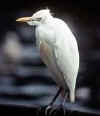 coloration.
coloration.
Cattle Egrets are everywhere in Florida. We see them trailing behind
mowers but most often scurrying about the meadow munching on insects
stirred as cattle kick up the turf.
Coots are an annual
migrant. Their call resembles their name. Their numbers increase
slowly as the temperature up north decreases. We seldom see them on
land. A plump
body like this is very awkward out of the water. In some areas they
are considered a nuisance due to sheer numbers.
as the temperature up north decreases. We seldom see them on
land. A plump
body like this is very awkward out of the water. In some areas they
are considered a nuisance due to sheer numbers.
Mourning doves are also a prominent avian presence at Fontana Point. They coo softly to
one another and startle easily. On cold mornings they love the pool
area where they rest on the warm pavement in a patch of sunlight. These
are the birds that sit in the tree over your vehicle!
also a prominent avian presence at Fontana Point. They coo softly to
one another and startle easily. On cold mornings they love the pool
area where they rest on the warm pavement in a patch of sunlight. These
are the birds that sit in the tree over your vehicle! 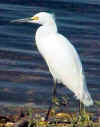
The Snowy Egret
is another full time resident. You can tell from the pointy beak that
it's a fisher. Sometimes they are mistaken for herons but they are
actually much
smaller.
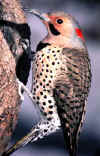 On the left is a Flicker. They're one variety of woodpecker. You
may often see holes in palm trees and hear their call. Sturdy feet and
stiff tail feathers make it possible for them to cling to the sides of
a tree and peck holes to reveal insects and grubs... yum!
On the left is a Flicker. They're one variety of woodpecker. You
may often see holes in palm trees and hear their call. Sturdy feet and
stiff tail feathers make it possible for them to cling to the sides of
a tree and peck holes to reveal insects and grubs... yum! 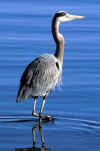
One of the
most lovely
species to frequent our lake are the herons. There are several
species. They do not have attractive voices and all are very shy. Most common
are the tri-colored or Louisiana Heron. Most attractive is perhaps the
Great White Heron (not pictured). Also the night herons are here. You
hear them squawk in the night and splash in the wake. There are
actually two species at Fontana Point. Mostly white breasted and the
Tiger throated.
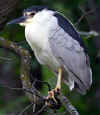 Another unique resident on our shores is
the Ibis. Generally white (only the young
Another unique resident on our shores is
the Ibis. Generally white (only the young appear grayish), Ibis prowl the turf with long specialized beaks
probing for insects. They are also somewhat shy and
will allow no one to approach too closely.
appear grayish), Ibis prowl the turf with long specialized beaks
probing for insects. They are also somewhat shy and
will allow no one to approach too closely.
One of the most
impressive species to be seen around our community is the Osprey. A
large fishing predator similar to a hawk or an eagle. In truth they
will also dine on chicks, small turtles lizards and pretty much
anything that can't
chicks, small turtles lizards and pretty much
anything that can't
 get away! We also see them sitting on enormous
nests at pole and tree tops.
get away! We also see them sitting on enormous
nests at pole and tree tops.
A number of web footed friends love
our lake
year round. Perhaps most
notable is the Muscovy duck (pictured left). A very insistent species of scavenger and not a desirable resident.
Females
will sit three times a year with a clutch of 12 eggs making a huge
gaggle in a very brief time. You can tell when someone has been
feeding them because they become  'imprinted'. Each time they see our upright
form they rush to be fed.
'imprinted'. Each time they see our upright
form they rush to be fed.
There are several migratory species. Mallards are colorful and very much smaller
than Muscovies. Also,
Ring-Necked
Ducks are seen to float as little rafts throughout the winter. Like the Coot,
Ring-Necked Ducks seldom leave the security of the water.
Muscovies. Also,
Ring-Necked
Ducks are seen to float as little rafts throughout the winter. Like the Coot,
Ring-Necked Ducks seldom leave the security of the water.
In the Spring each year we are
treated to the Oriole. The bright contrast of black and orange is very
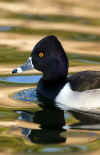 distinctive. Their call is a kind of
distinctive. Their call is a kind of 'whooping'. Though the Mockingbird is actually the official bird of
Texas its' presence in Florida and at Fontana Point is truly dominant.
They can sometimes be a bit aggressive as they 'dive bomb' you when
their nest feels threatened. They have a great variety of remarkably complicated calls. One can
say
that they are emblematic of southern nights.
'whooping'. Though the Mockingbird is actually the official bird of
Texas its' presence in Florida and at Fontana Point is truly dominant.
They can sometimes be a bit aggressive as they 'dive bomb' you when
their nest feels threatened. They have a great variety of remarkably complicated calls. One can
say
that they are emblematic of southern nights.
Perhaps the final flying
species on our wildlife page is the turkey vulture. Circling overhead in the
stiff fall winds, they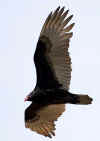 search for the unfortunate casualties of other species. Being very
large birds, it's fascinating to watch them swoop and dip, landing to
feed
search for the unfortunate casualties of other species. Being very
large birds, it's fascinating to watch them swoop and dip, landing to
feed  only when the coast is clear.
only when the coast is clear.
Lets not forget two rather hidden
residents of our lake. The first happens to be a sometimes large
terrapin, the Florida soft-shell turtle. We see them poke long snouts
above the surface and disappear at the slightest movement.
We
also host the grand daddy of Florida lizards, the iguana.  Sometimes
reaching 4 feet in length and weighing in at several pounds. The
iguana is quiet and shy. Capable as any lizard of remaining motionless
for long periods of time, perhaps this is why many have chosen to keep
them as
pets.
Finally
on
the
bottom
right
is
an
amazing
sadly
un-credited
image
of
of
the
very
rare
Louisiana
or
Tri-colored
Heron.
Sometimes
reaching 4 feet in length and weighing in at several pounds. The
iguana is quiet and shy. Capable as any lizard of remaining motionless
for long periods of time, perhaps this is why many have chosen to keep
them as
pets.
Finally
on
the
bottom
right
is
an
amazing
sadly
un-credited
image
of
of
the
very
rare
Louisiana
or
Tri-colored
Heron.
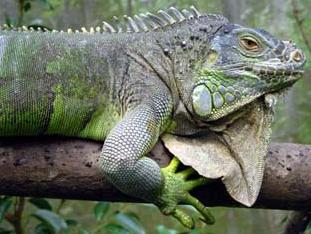
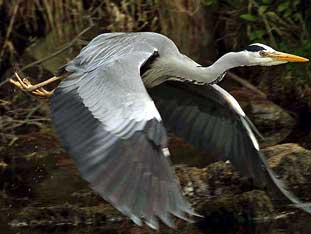
* On the top right of this page is pictured
the Monk Parakeet. We see them flocking together in noisy groups. They
love our warm climate and are well established even into South
America. Those who have tried to keep them as pets discover they're too
vocal (they are left in cages on the outside porch).
